Soft Start-Up Control Strategy for Dual Active Bridge Converter with a Supercapacitor
Abstract
1. Introduction
2. Concept of Soft Start-up for DAB Converter
3. Proposed Controller and Algorithm
3.1. Proposed 3-Step Soft Start-up Operation
3.2. Designed 3-Step Soft Start-up Algorithm for DAB Converter
4. The DAB Converter Design
5. Simulation Results
6. Experimental Setup
7. Results and Discussion
8. Conclusions
Author Contributions
Funding
Conflicts of Interest
References
- Pearce, J.M. Photovoltaics—A path to sustainable futures. Futures 2002, 34, 663–674. [Google Scholar] [CrossRef]
- Kharseh, M.; Wallbaum, H. How adding a battery to a grid-connected photovoltaic system can increase its economic performance: A comparison of different scenarios. Energies 2019, 12, 30. [Google Scholar] [CrossRef]
- Murphy, F.; McDonnell, K. A feasibility assessment of photovoltaic power systems in Ireland; a case study for the Dublin region. Sustainability 2017, 9, 302. [Google Scholar] [CrossRef]
- Atawi, I.E.; Kassem, A.M.; Zaid, S.A. Modeling, management, and control of an autonomous wind/fuel cell micro-grid system. Processes 2019, 7, 85. [Google Scholar] [CrossRef]
- Mutarraf, M.U.; Terriche, Y.; Niazi, K.A.K.; Vasquez, J.C.; Guerrero, J.M. Energy storage systems for shipboard microgrids—A Review. Energies 2018, 11, 3492. [Google Scholar] [CrossRef]
- Doerry, N.; Amy, J.; Krolick, C. History and the status of electric ship propulsion, integrated power systems, and future trends in the US Navy. Proc. IEEE 2015, 103, 2243–2251. [Google Scholar] [CrossRef]
- Li, X.; Hui, D.; Lai, X. Battery energy storage station (BESS)-based smoothing control of photovoltaic (PV) and wind power generation fluctuations. IEEE Trans. Sustain. Energy 2013, 4, 464–473. [Google Scholar] [CrossRef]
- Jeong, D.-K.; Ryu, M.-H.; Kim, H.-S.; Kim, H.-J. Optimized design of bi-directional dual active bridge converter for low-voltage battery charger. J. Power Electron. 2014, 14, 468–477. [Google Scholar] [CrossRef]
- Yun, H.-J.; Kim, H.-S.; Kim, M.; Baek, J.-W.; Kim, H.-J. A DAB converter with common-point-connected winding transformers suitable for a single-phase 5-level SST system. Energies 2018, 11, 928. [Google Scholar] [CrossRef]
- Yun, C.-G.; Cho, Y. Active hybrid solid state transformer based on multi-level converter using SiC MOSFET. Energies 2019, 12, 66. [Google Scholar] [CrossRef]
- Wang, S.; Wang, S.; Cui, Y.; Long, J.; Ren, F.; Ji, S.; Wang, S. An experimental study of the sweep frequency impedance method on the winding deformation of an onsite power transformer. Energies 2020, 13, 3511. [Google Scholar] [CrossRef]
- Sathishkumar, P.; Piao, S.; Khan, M.A.; Kim, D.-H.; Kim, M.-S.; Jeong, D.-K.; Lee, C.; Kim, H.-J. A blended SPS-ESPS Control DAB-IBDC converter for a standalone solar power system. Energies 2017, 10, 1431. [Google Scholar] [CrossRef]
- Lei, T.; Wu, C.; Liu, X. Multi-objective optimization control for the aerospace dual-active bridge power converter. Energies 2018, 11, 1168. [Google Scholar] [CrossRef]
- Xiong, F.; Wu, J.; Hao, L.; Liu, Z. Backflow power optimization control for dual active bridge DC-DC converters. Energies 2017, 10, 1403. [Google Scholar] [CrossRef]
- Jeong, D.-K.; Kim, H.-S.; Baek, J.-W.; Kim, H.-J.; Jung, J.-H. Autonomous control strategy of DC microgrid for islanding mode using power line communication. Energies 2018, 11, 924. [Google Scholar] [CrossRef]
- Aamir, M.; Mekhilef, S. An online transformerless uninterruptible power supply (ups) system with a smaller battery bank for low-power applications. IEEE Trans. Power Electr. 2017, 32, 233–247. [Google Scholar] [CrossRef]
- Komurcugil, H. Rotating-sliding-line-based sliding-mode control for single-phase ups inverters. IEEE Trans. Ind. Electr. 2012, 59, 3719–3726. [Google Scholar] [CrossRef]
- Deng, H.; Oruganti, R.; Srinivasan, D. Analysis and design of iterative learning control strategies for ups. inverters. IEEE Trans. Ind. Electr. 2007, 54, 1739–1751. [Google Scholar] [CrossRef]
- Rani, J.R.; Thangavel, R.; Oh, S.-I.; Lee, Y.S.; Jang, J.-H. An ultra-high-energy density supercapacitor; fabrication based on thiol-functionalized graphene oxide scrolls. Nanomaterials 2019, 9, 148. [Google Scholar] [CrossRef]
- Kanaka Durga, I.; Srinivasa Rao, S.; Ahn, J.-W.; Park, T.-Y.; Jin-Soo, B.; Ho, C.-I.; Prabakar, K.; Kim, H.-J. Dice-like nanostructure of a CuS@PbS composite for high-performance supercapacitor electrode applications. Energies 2018, 11, 1624. [Google Scholar] [CrossRef]
- Scalia, A.; Bella, F.; Lamberti, A.; Bianco, S.; Gerbaldi, C.; Tresso, E.; Pirri, C.F. A flexible and portable powerpack by solid-state supercapacitor and dye-sensitized solar cell integration. J. Power Sour. 2017, 359, 311–321. [Google Scholar] [CrossRef]
- Chauhan, H.; Singh, M.K.; Hashmi, S.A.; Deka, S. Synthesis of surfactant-free SnS nanorods by a solvothermal route with better electrochemical properties towards supercapacitor applications. RSC Adv. 2015, 5, 17228–17235. [Google Scholar] [CrossRef]
- Ali, M.U.; Zafar, A.; Nengroo, S.H.; Hussain, S.; Junaid Alvi, M.; Kim, H.-J. Towards a smarter battery management system for electric vehicle applications: A critical review of lithium-ion battery state of charge estimation. Energies 2019, 12, 446. [Google Scholar] [CrossRef]
- Liu, Y.; Jiang, K.; Yang, S. Integrated anode electrode composited Cu–Sn alloy and separator for microscale lithium ion batteries. Materials 2019, 12, 603. [Google Scholar] [CrossRef] [PubMed]
- Simon, P.; Gogotsi, Y. Materials for electrochemical capacitors. Nat. Mater. 2008, 7, 845–854. [Google Scholar] [CrossRef]
- Peng, H.; Ma, G.; Mu, J.; Sun, K.; Lei, Z. Controllable synthesis of CuS with hierarchical structures via a surfactant-free method for high-performance supercapacitors. Mater. Lett. 2014, 122, 25–28. [Google Scholar] [CrossRef]
- Tooming, T.; Thomberg, T.; Kurig, H.; Jänes, A.; Lust, E. High power density supercapacitors based on the carbon dioxide activated D-glucose derived carbon electrodes and 1-Ethyl-3-methylimidazolium tetrafluoroborate ionic liquid. J. Power Sour. 2015, 280, 667–677. [Google Scholar] [CrossRef]
- Hong, S.-J.; Hyun, S.-W.; Kang, K.-M.; Lee, J.-H.; Won, C.-Y. Improvement of transient state response through feedforward compensation method of AC/DC power conversion system (PCS) based on space vector pulse width modulation (SVPWM). Energies 2018, 11, 1468. [Google Scholar] [CrossRef]
- Khan, M.A.; Zeb, K.; Sathishkumar, P.; Ali, M.U.; Uddin, W.; Hussain, S.; Ishfaq, M.; Khan, I.; Cho, H.-G.; Kim, H.-J. A novel supercapacitor/lithium-ion hybrid energy system with a fuzzy logic-controlled fast charging and intelligent energy management system. Electronics 2018, 7, 63. [Google Scholar] [CrossRef]
- Lee, D.-M.; Hyun, S.-W.; Kang, J.-W.; Noh, Y.-S.; Won, C.-Y. A control strategy for bidirectional isolated 3-phase current-fed dual active bridge converter. Electronics 2018, 7, 214. [Google Scholar] [CrossRef]
- Litrán, S.P.; Durán, E.; Semião, J.; Barroso, R.S. Single-switch bipolar output DC-DC converter for photovoltaic application. Electronics 2020, 9, 1171. [Google Scholar] [CrossRef]
- Yoon, D.; Lee, S.; Cho, Y. Design considerations of series-connected devices based LLC converter. Energies 2020, 13, 264. [Google Scholar] [CrossRef]
- Fang, Z.; Wang, J.; Duan, S.; Shao, J.; Hu, G. Stability analysis and trigger control of LLC resonant converter for a wide operational range. Energies 2017, 10, 1448. [Google Scholar] [CrossRef]
- Sathishkumar, P.; Krishna, T.N.V.; Khan, M.A.; Zeb, K.; Kim, H.-J. Digital soft start implementation for minimizing start up transients in high power DAB-IBDC converter. Energies 2018, 11, 956. [Google Scholar] [CrossRef]
- Xu, W.; Chan, N.H.L.; Or, S.W.; Ho, S.L.; Chan, K.W. A new control method for a bi-directional phase-shift-controlled DC-DC converter with an extended load range. Energies 2017, 10, 1532. [Google Scholar] [CrossRef]
- Rico, J.J.; Acha, E.; Madrigal, M. The study of inrush current phenomenon using operational matrices. IEEE Trans. Power Deliv. 2001, 16, 231–237. [Google Scholar] [CrossRef]
- Ge, B.; de Almeida, A.T.; Zheng, Q.; Wang, X. An equivalent instantaneous inductance-based technique for discrimination between inrush current and internal faults in power transformers. IEEE Trans. Power Deliv. 2005, 20, 2473–2482. [Google Scholar]
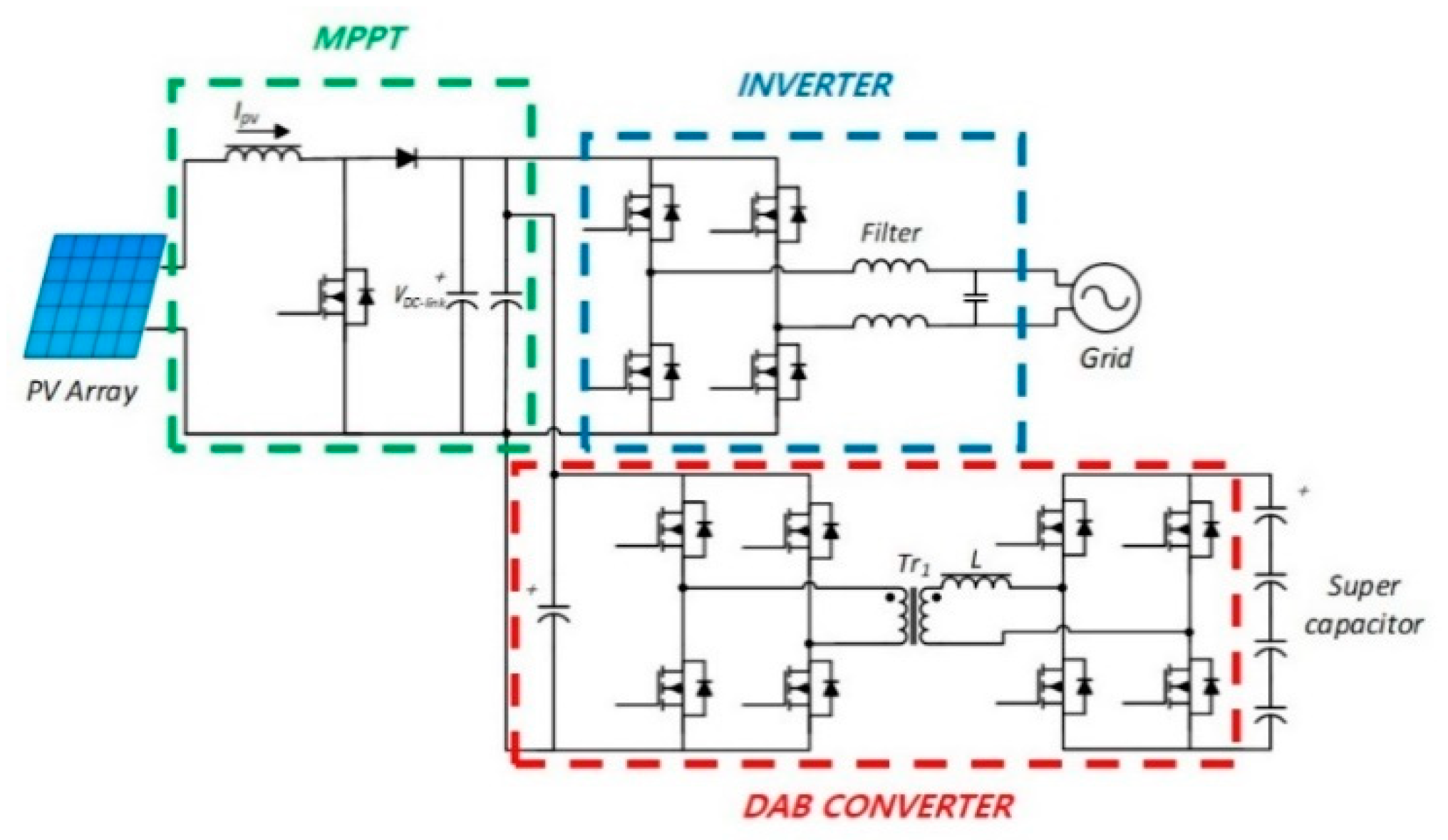
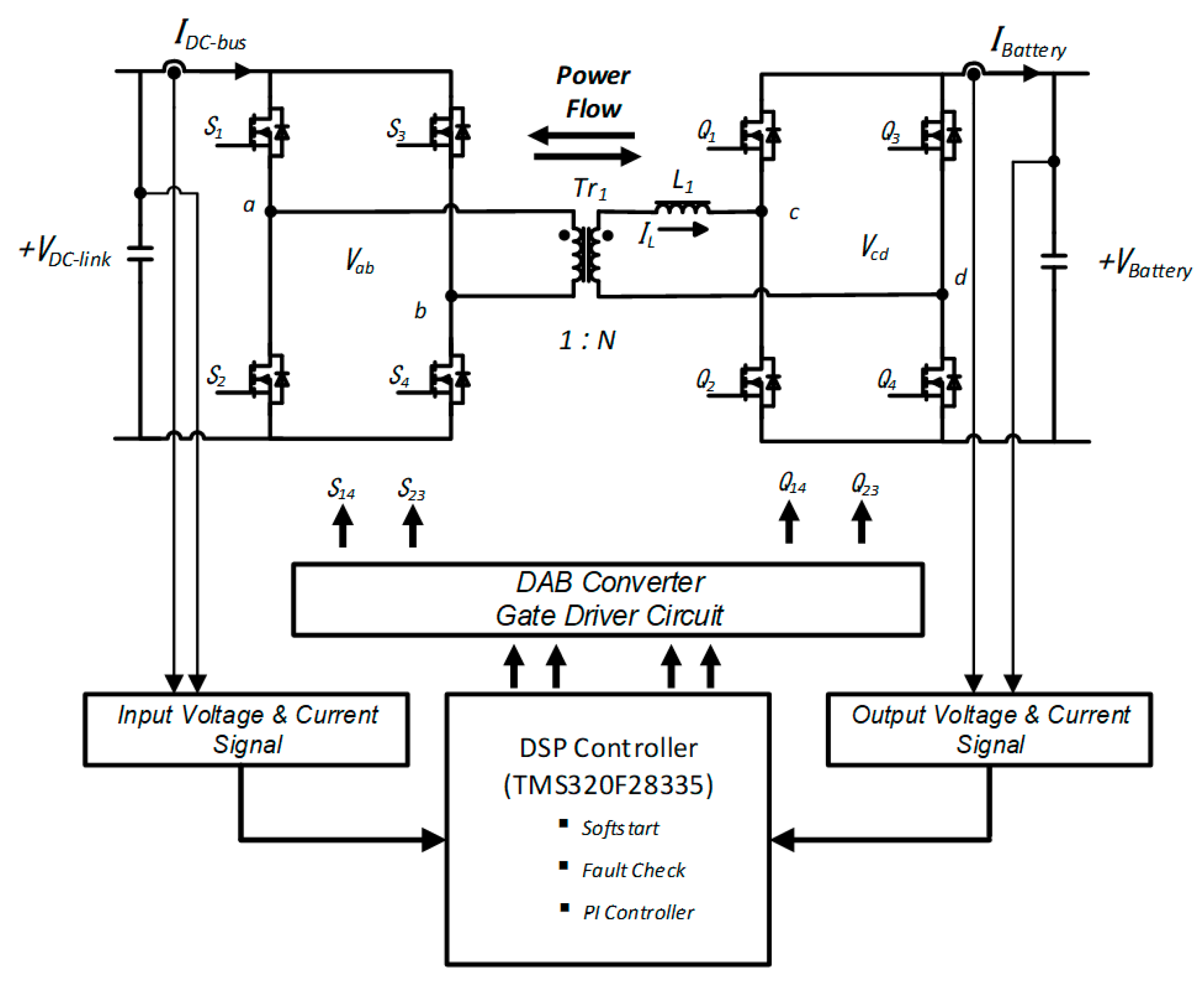
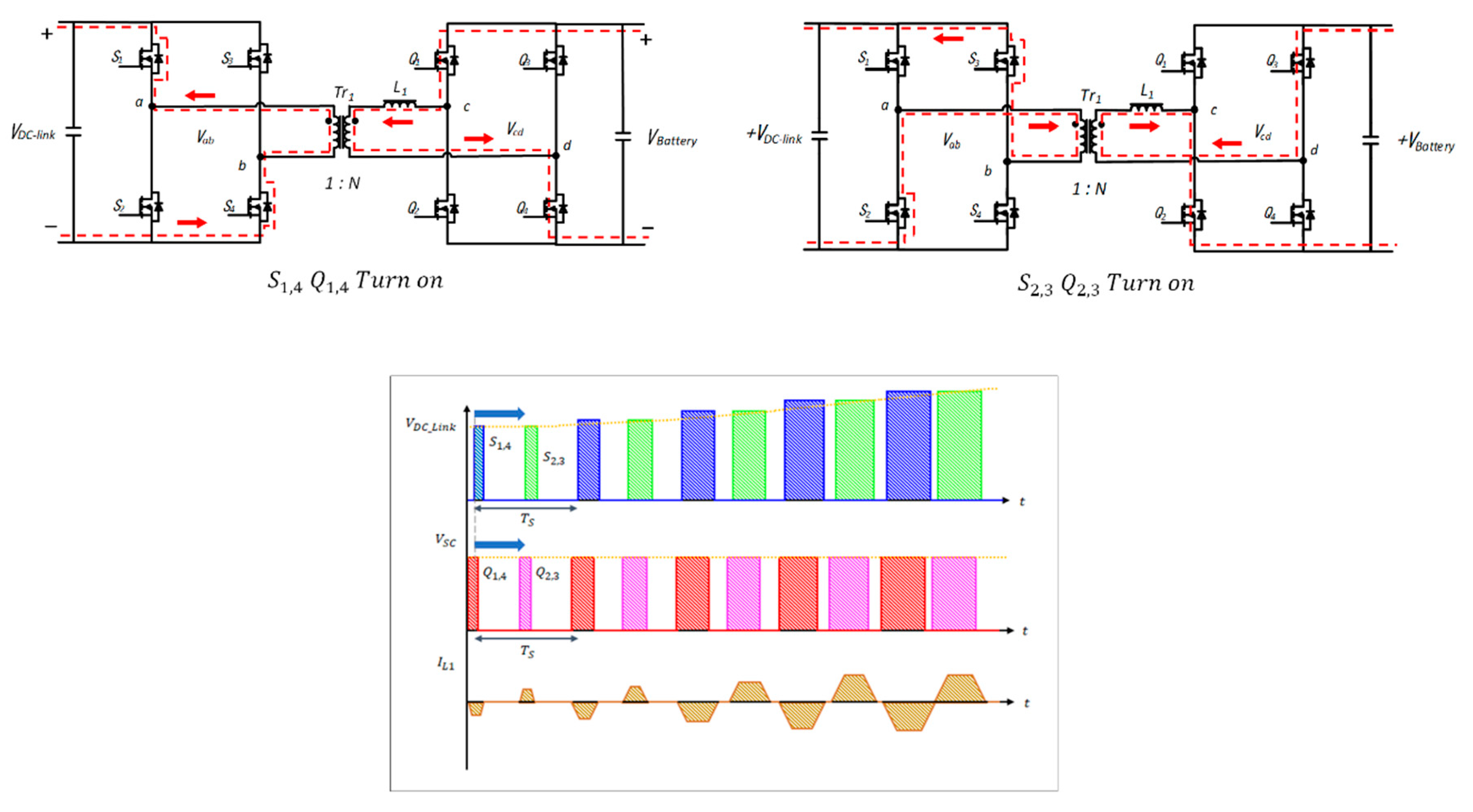
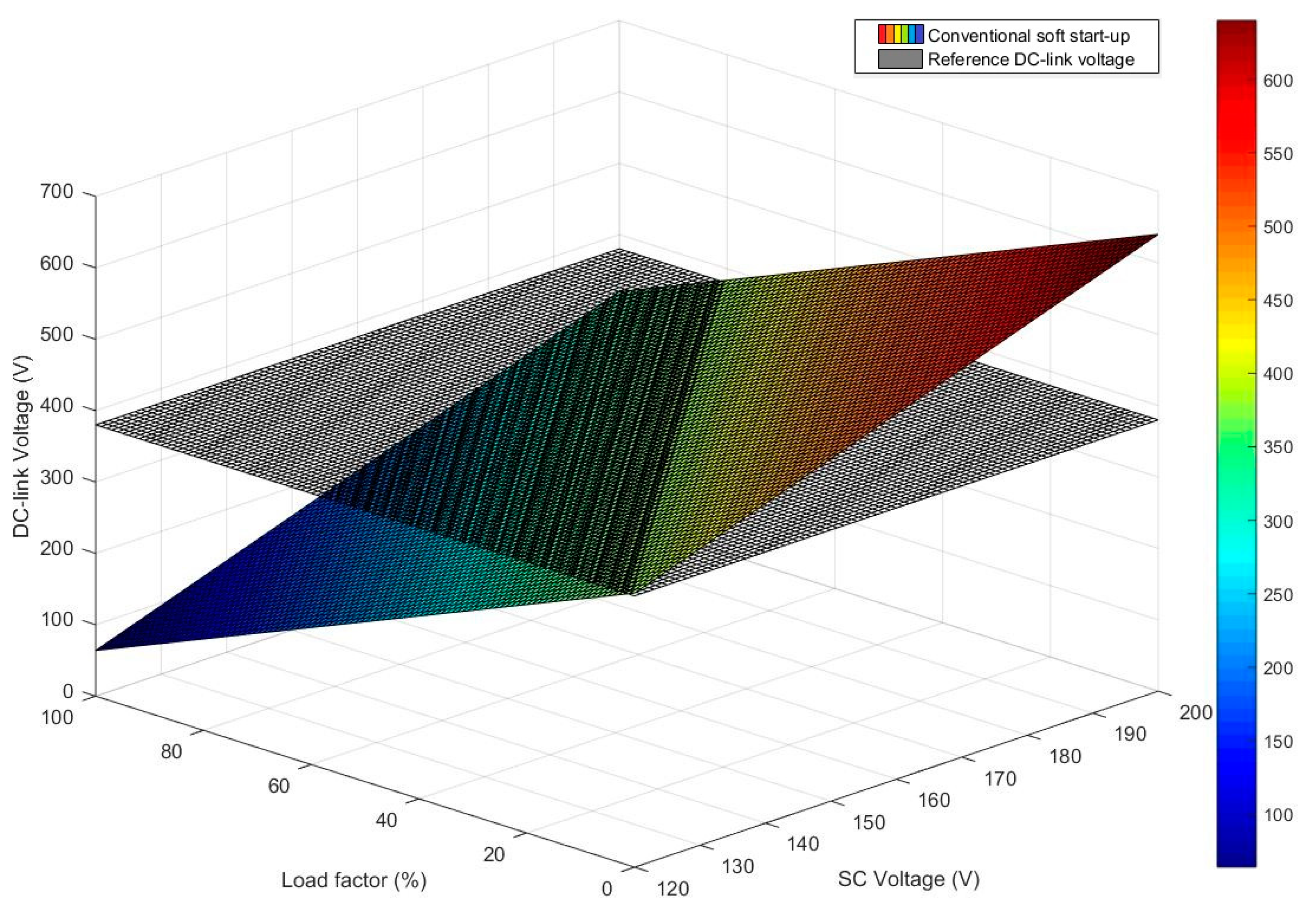
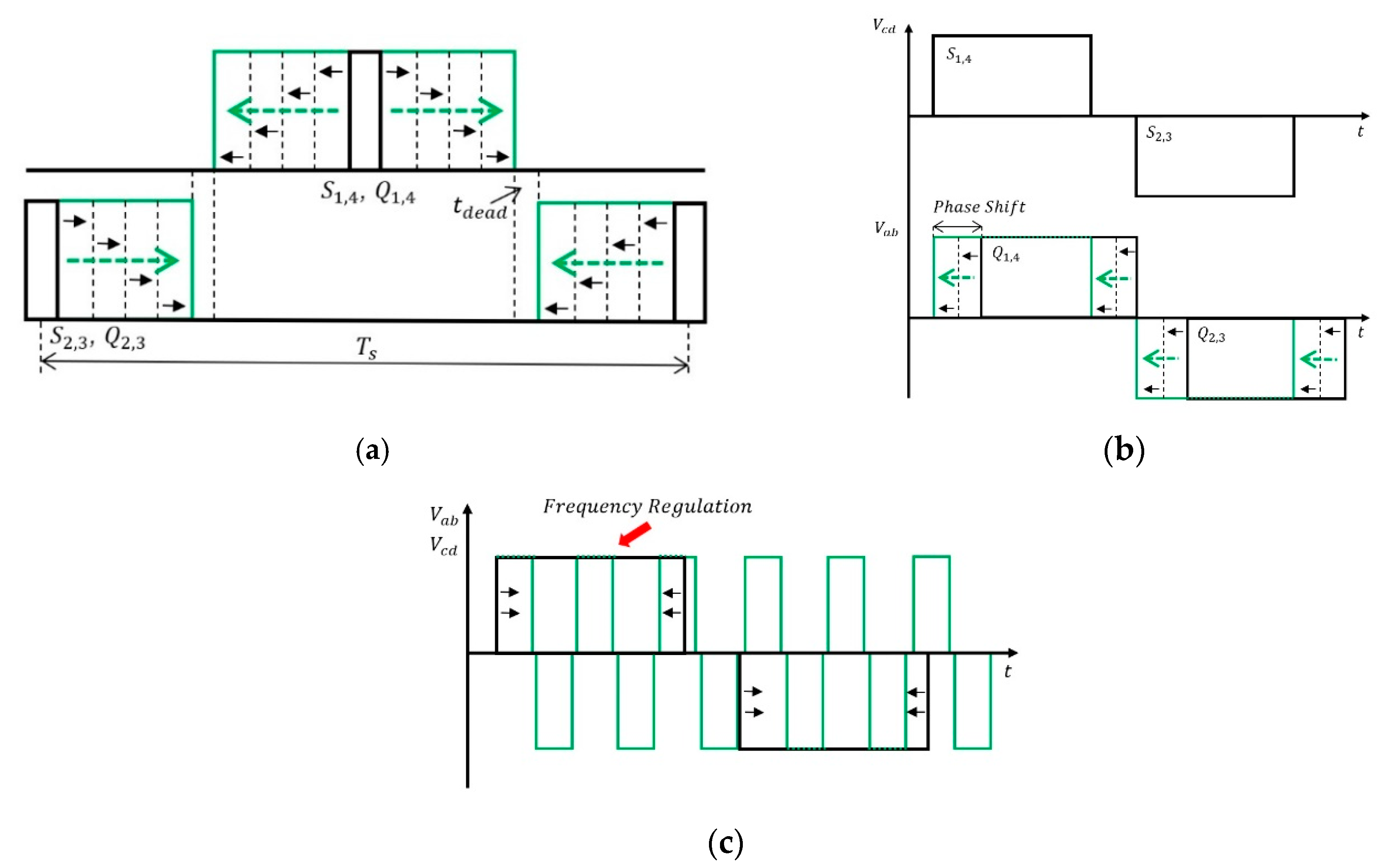
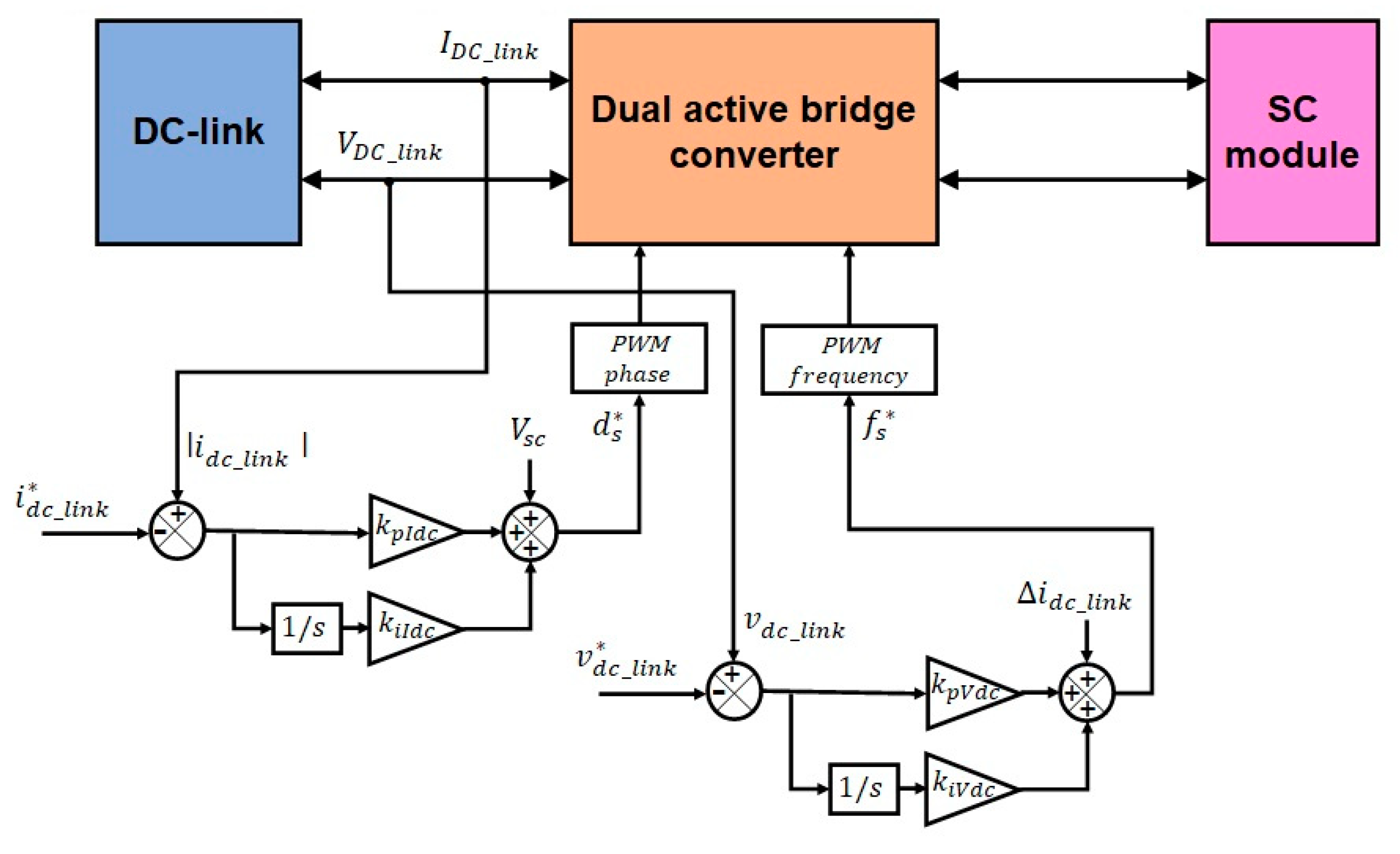
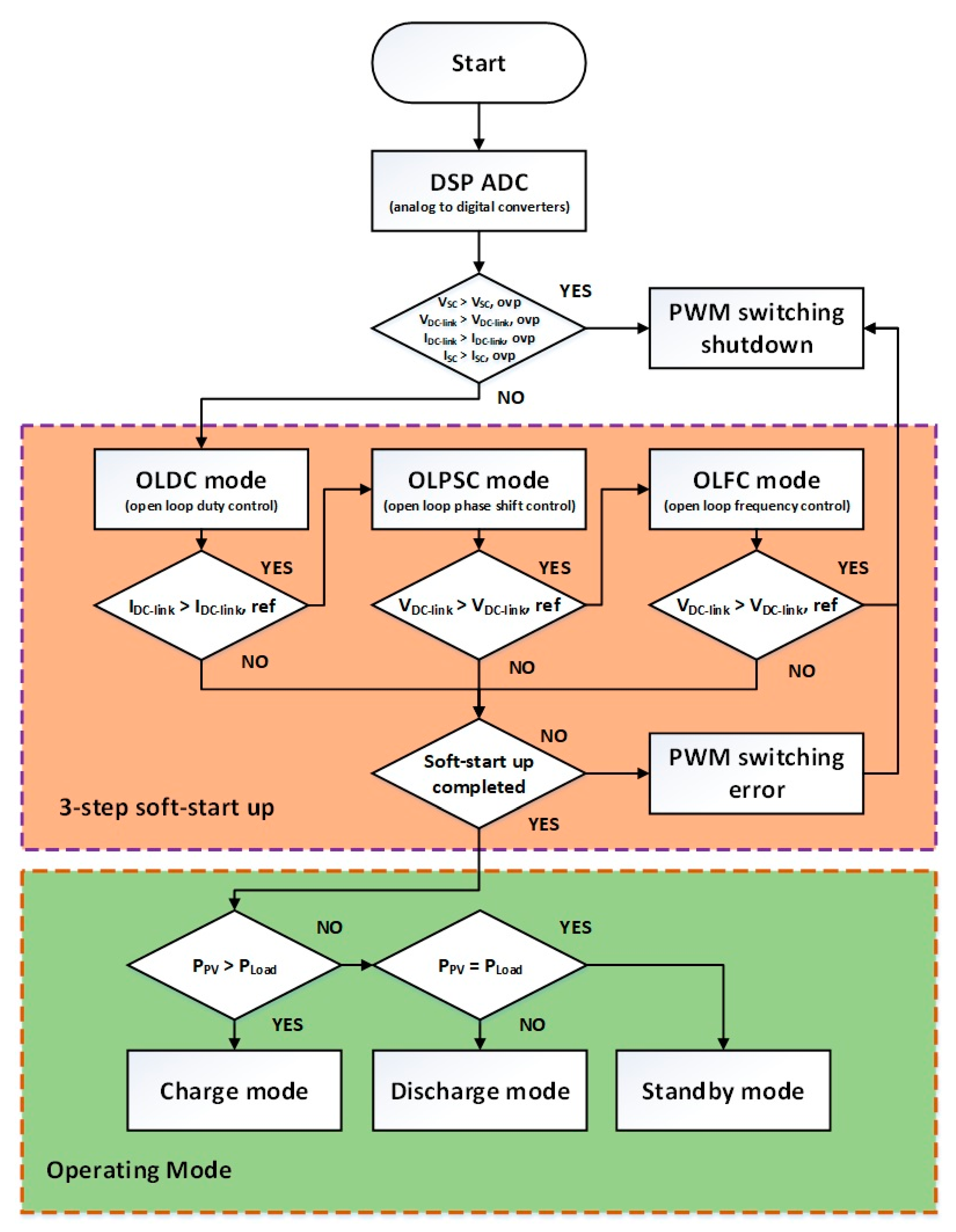
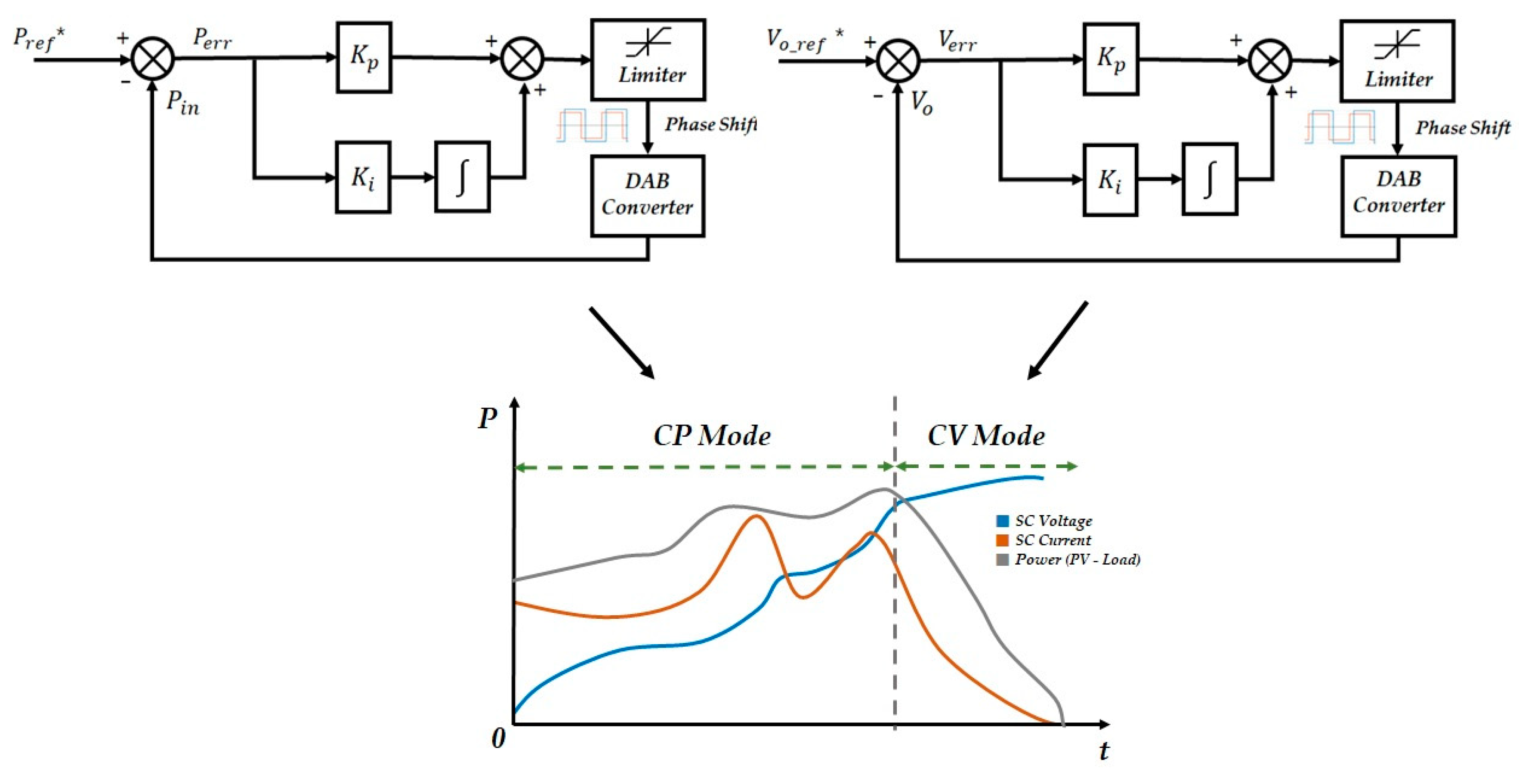

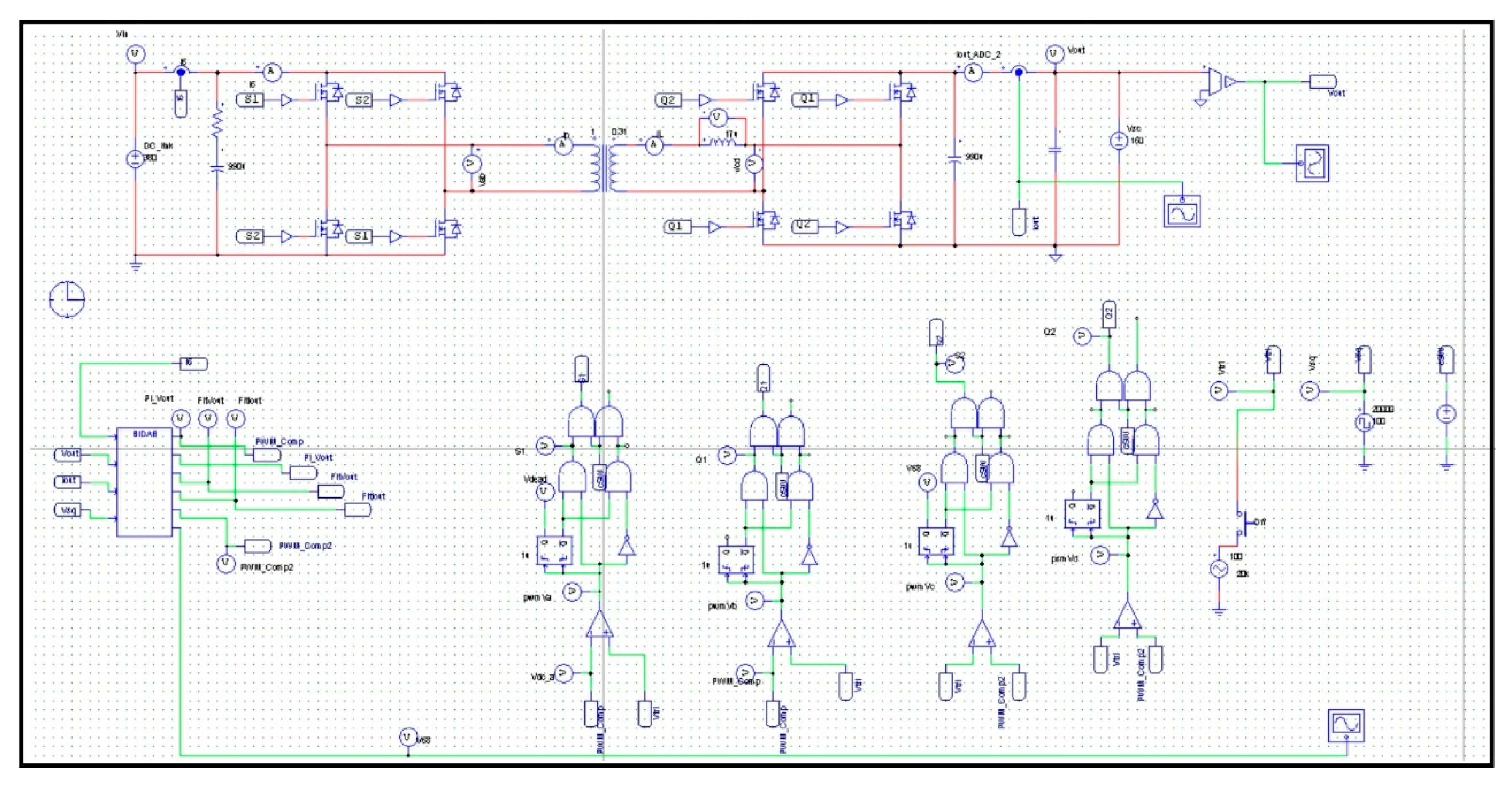
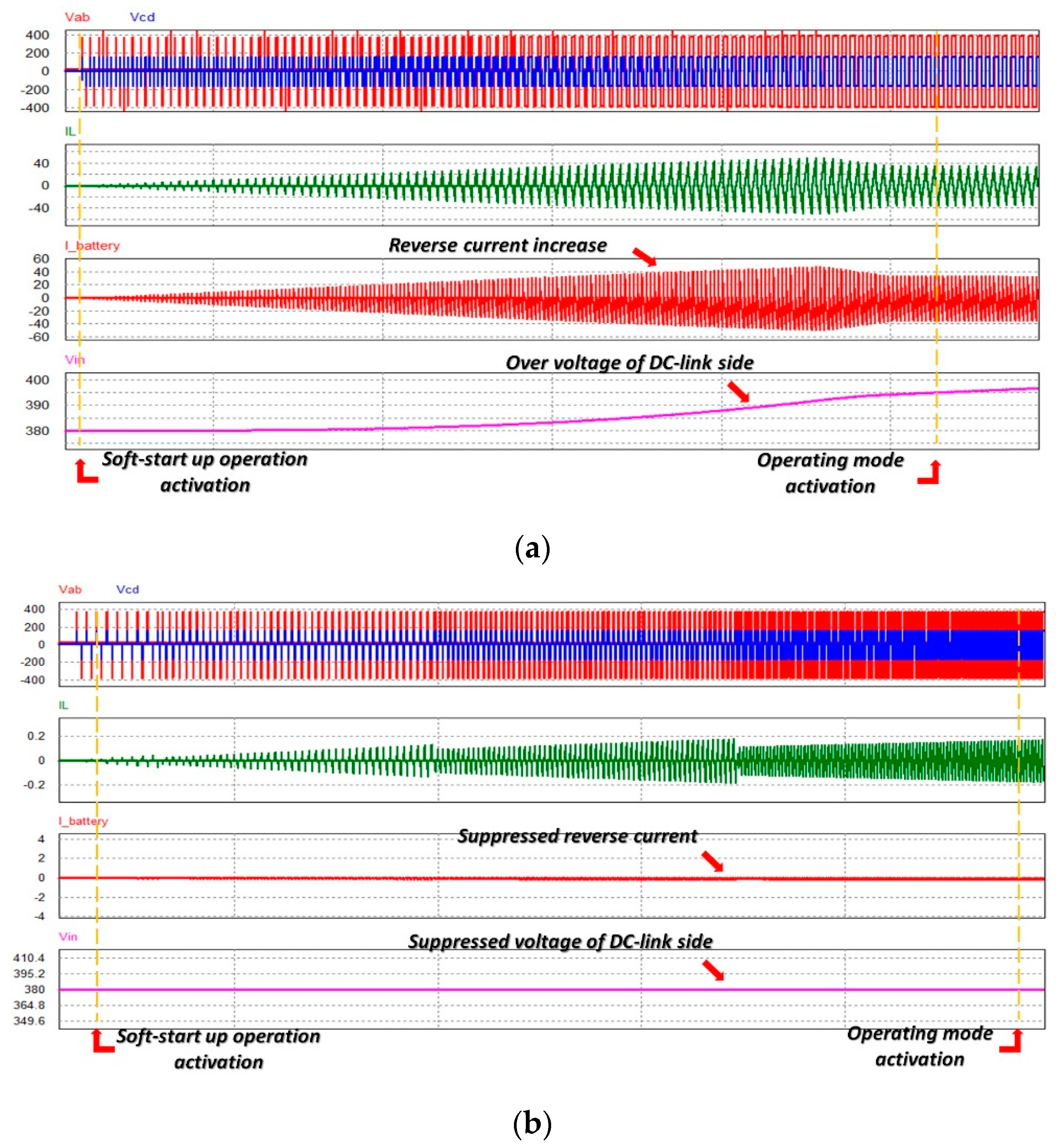




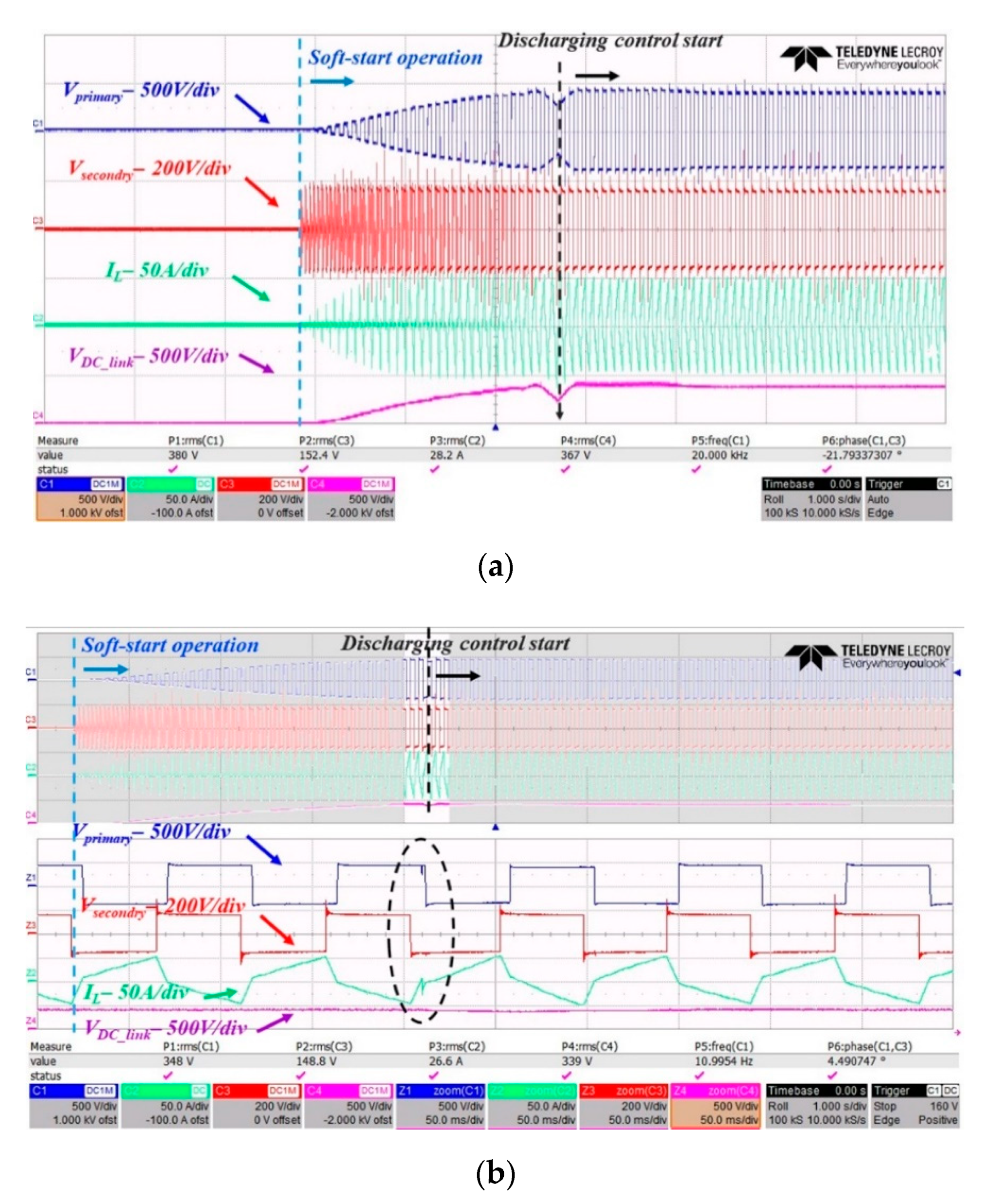

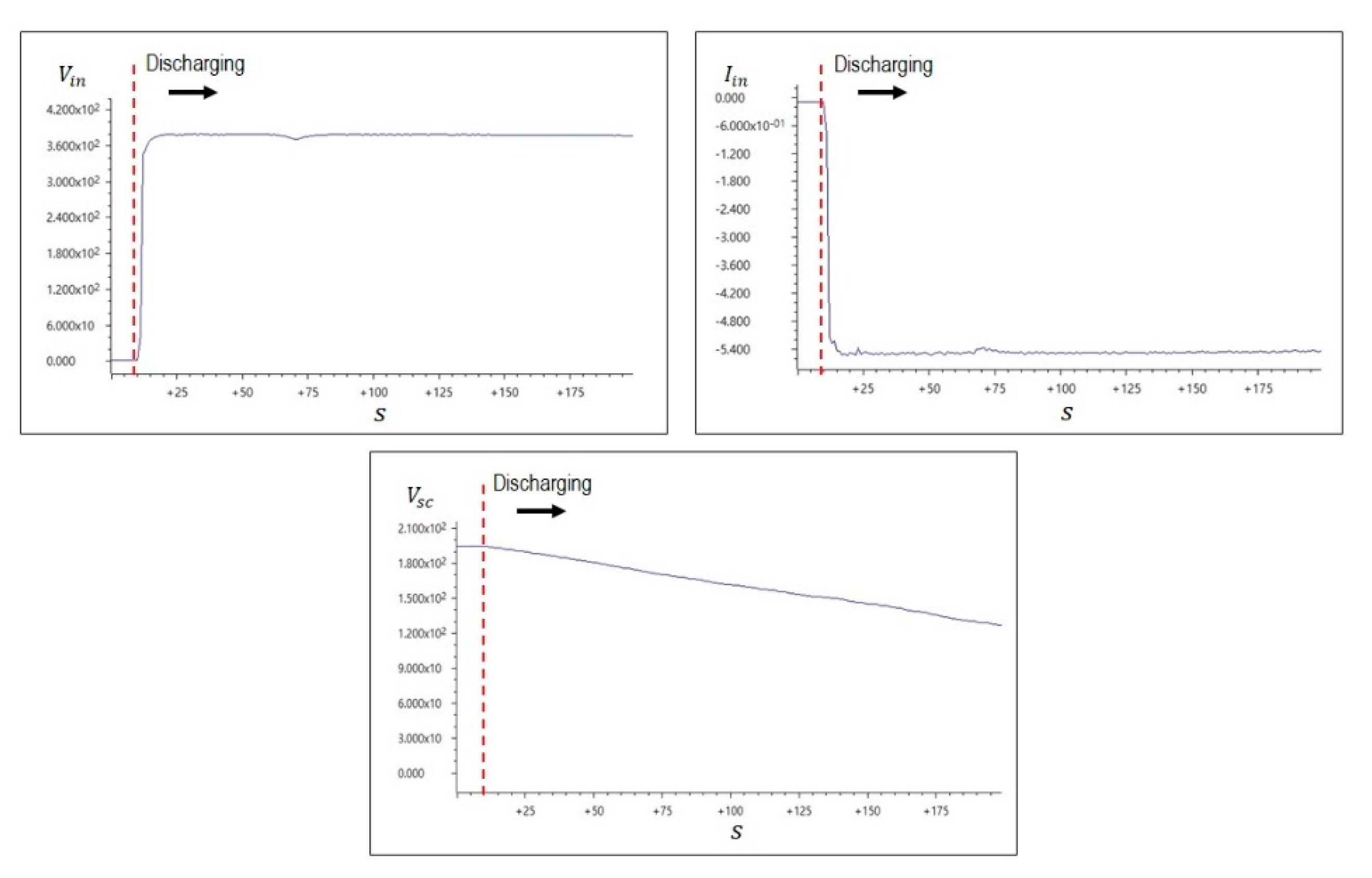
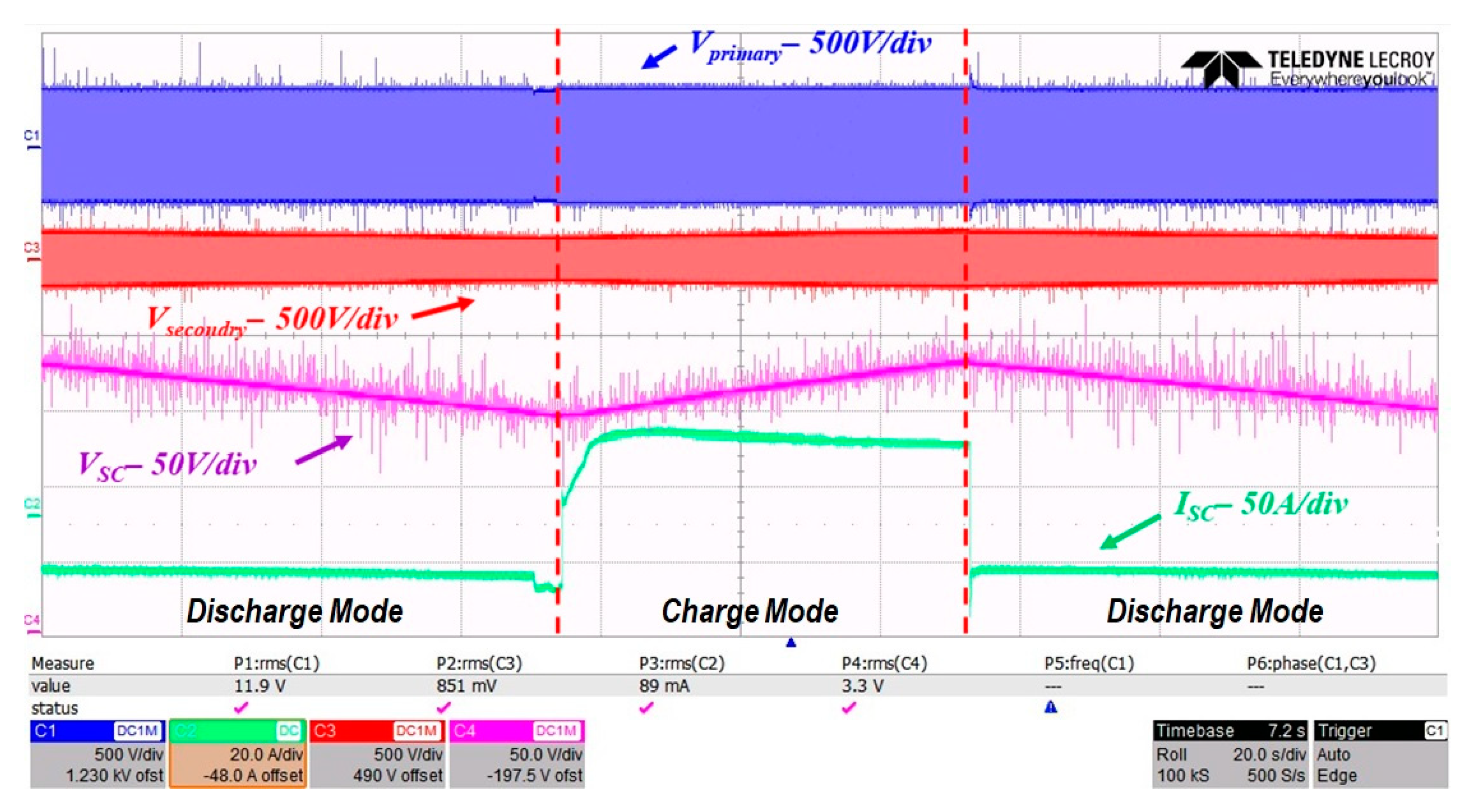
| Parameter | Value |
|---|---|
| Power | 5 kW |
| Input voltage | 380 VDC |
| Output voltage | 120 V~200 VDC |
| Switching frequency | 20~50 kHz |
| Leakage inductance | 17 µH |
| Transformer turn ratio | 3.1:1 |
| Input capacitance | 990 uF |
| Output capacitance | 990 uF |
| Parameter | Value |
|---|---|
| Rated voltage | 45 V |
| Capacitance | 165 F |
| Maximum ESR | 6.0 mΩ |
| Stored energy | 53 Wh |
| Maximum current | 1900 A |
| Duty cycles | Up to 100,000 cycles |
© 2020 by the authors. Licensee MDPI, Basel, Switzerland. This article is an open access article distributed under the terms and conditions of the Creative Commons Attribution (CC BY) license (http://creativecommons.org/licenses/by/4.0/).
Share and Cite
Kim, M.-S.; Kim, D.-H.; Jeong, D.-K.; Kim, J.-M.; Kim, H.-J. Soft Start-Up Control Strategy for Dual Active Bridge Converter with a Supercapacitor. Energies 2020, 13, 4083. https://doi.org/10.3390/en13164083
Kim M-S, Kim D-H, Jeong D-K, Kim J-M, Kim H-J. Soft Start-Up Control Strategy for Dual Active Bridge Converter with a Supercapacitor. Energies. 2020; 13(16):4083. https://doi.org/10.3390/en13164083
Chicago/Turabian StyleKim, Min-Soo, Do-Hyun Kim, Dong-Keun Jeong, Jang-Mok Kim, and Hee-Je Kim. 2020. "Soft Start-Up Control Strategy for Dual Active Bridge Converter with a Supercapacitor" Energies 13, no. 16: 4083. https://doi.org/10.3390/en13164083
APA StyleKim, M.-S., Kim, D.-H., Jeong, D.-K., Kim, J.-M., & Kim, H.-J. (2020). Soft Start-Up Control Strategy for Dual Active Bridge Converter with a Supercapacitor. Energies, 13(16), 4083. https://doi.org/10.3390/en13164083






